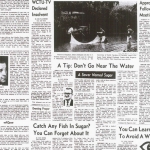Little Sugar’s intimacy with some of the city’s oldest neighborhoods made it vulnerable to centuries of callous treatment from residents, businesses and government, including sewage and industries’ chemical waste.
By Mary Newsom
If you dodge the poison ivy and briars surrounding a spot of woods behind Parks Chevrolet on North Tryon Street, and step around trashed plastic bottles and other debris, you might notice a bile-green puddle.
Nearby are moss-covered rocks and a few dingy culverts, one half-blocked with a metal tank. The greenish puddle might be simply leftover rainwater but more likely it’s a spring-fed seep.
That inauspicious pool cradles the birth of Little Sugar Creek, one of Charlotte’s most visible, historic and significant waterways. But this spot, like most of places where Mecklenburg’s creeks begin, has no cachet, no champions and little protection. It’s just a muddy area collecting trash.
In its time, Little Sugar Creek has killed. It has been called a sewer and a scourge. But change is coming. Prominent sections of the Little Sugar Creek greenway between uptown and Freedom Park are opening Charlotteans’ eyes to the value of their small waterways.
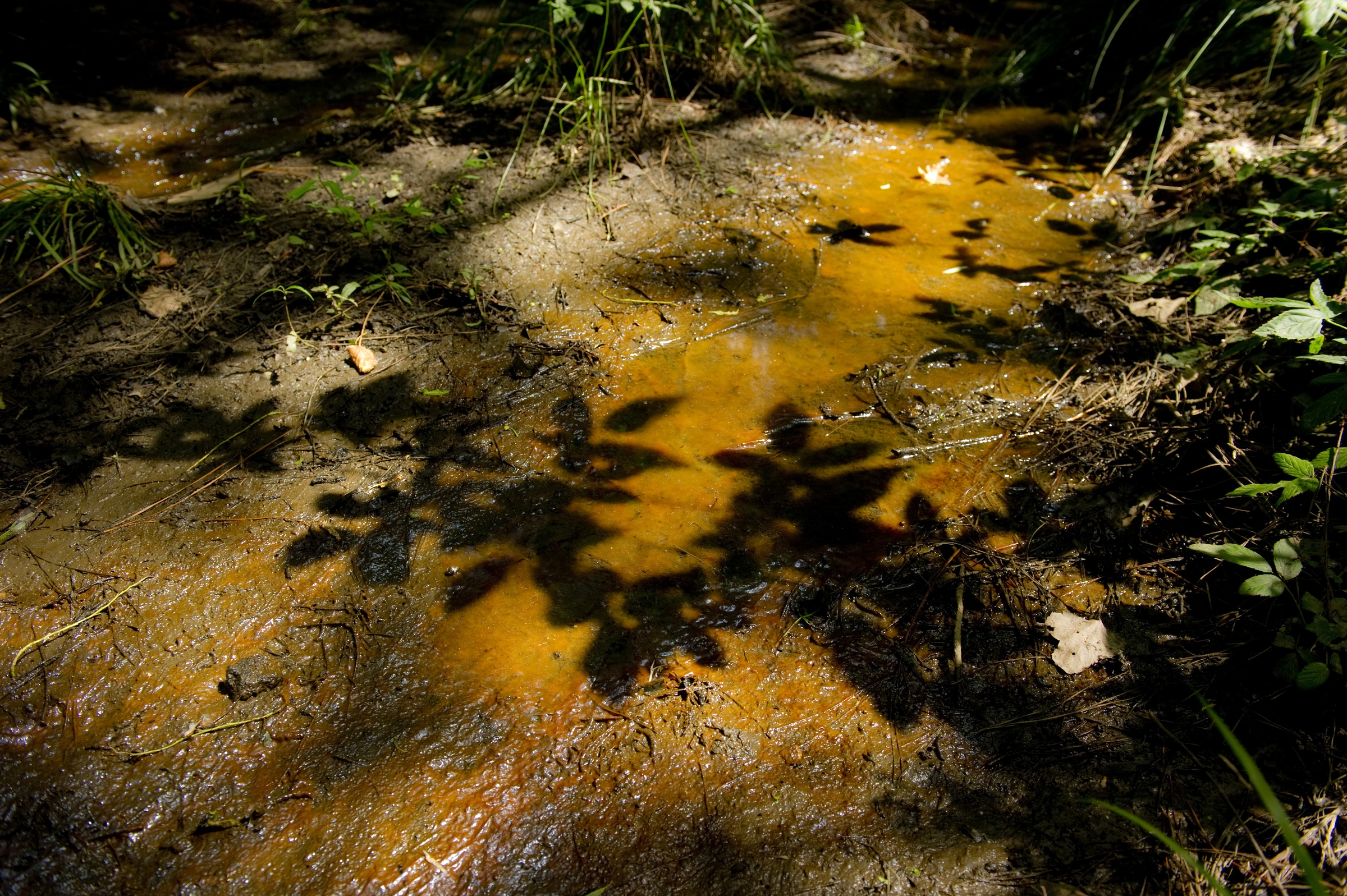
Little Sugar is more than a blue squiggle on a map. It offers a different vantage point from which to see Charlotte’s past and future. The creek and its tributaries run past historic homesites, faded factories, modest houses and mansions. It runs under trees and concrete. Along its banks are snakes, crawfish, raccoons and deer – and uncountable thousands of plastic bottles, Styrofoam cups and fading plastic bags.
Even its name evokes lost history: Little Sugar and Sugar creeks were named for the all-but-forgotten Sugaree Indians. Historians say “Sugaree” – sometimes spelled Sugaw or Shugar – meant “people of the river of water which is unfit to drink,” words all too prophetic. The Sugaree, weakened by Indian wars and European diseases in the 1700s, eventually joined the Catawba Indians’ settlement near today’s S.C. line.
Over time Little Sugar was called Sugar Creek or Sugaw Creek. Irwin Creek was once called Sugar Creek. Today Sugar Creek is the large west Charlotte stream into which Irwin Creek flows.
Little Sugar’s intimacy with some of the city’s oldest neighborhoods made it vulnerable to centuries of callous treatment from residents, businesses and government, including sewage and industries’ chemical waste. Machines dredged and straightened its bends. Engineers riprapped its banks with rocks. Highways and parking lots hid it.
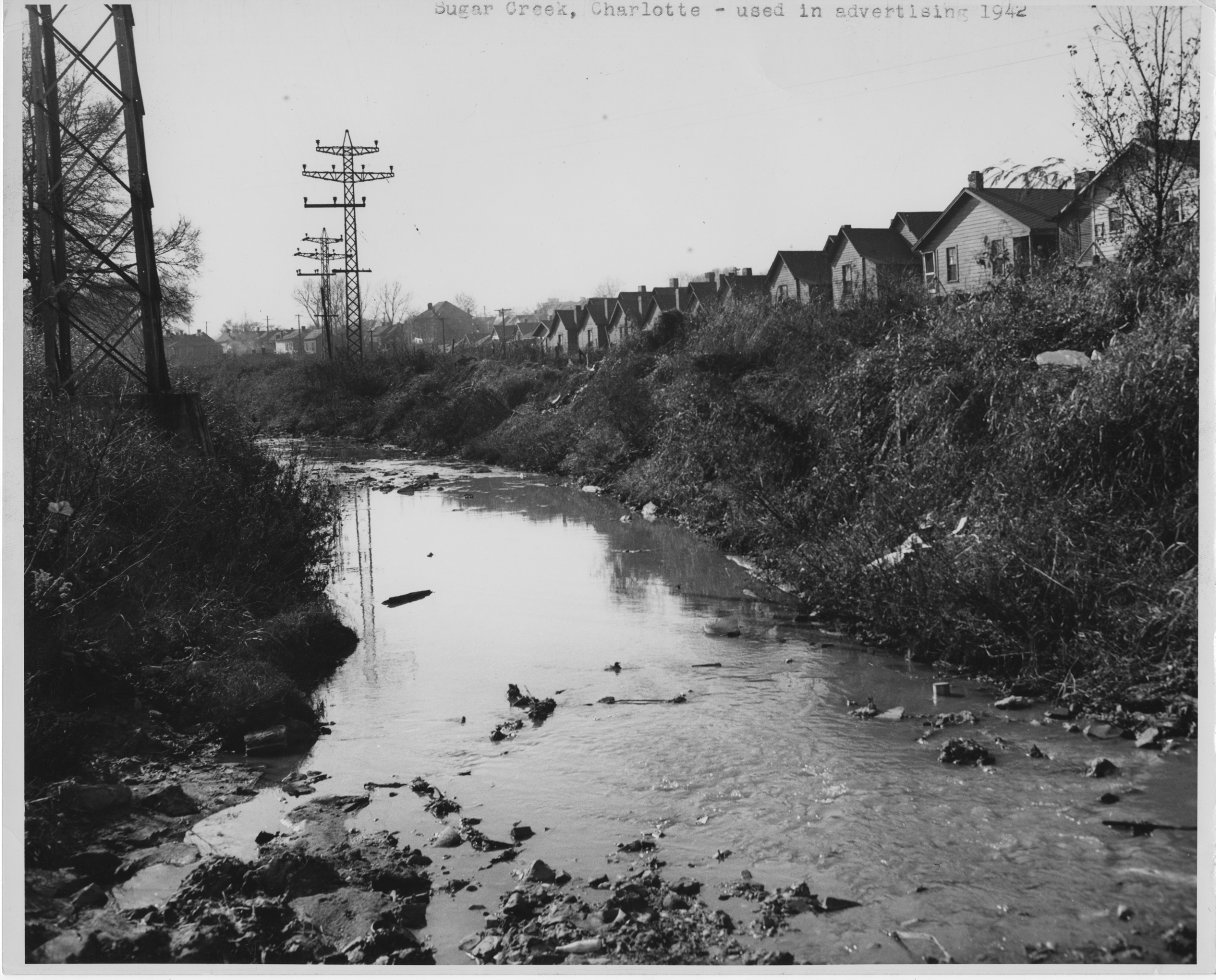
Much of Little Sugar’s route is unheralded, making a geographical sketch in order. The creek and its major tributary, Briar Creek, drain 51 square miles. Little Sugar Creek tumbles through Mecklenburg for 19 miles. It begins just west of a ridge dividing the Catawba River watershed and the Yadkin-Pee Dee watershed to the east. Little Sugar has multiple birthplaces, not just the bile-green seep. Some might say starts farther north, with Derita branch in the Derita community. Others point to a trickle piped under Interstate 85.
In the 1960s-era Hidden Valley neighborhood, its tributaries are little more than backyard ditches. Charlotte Chamber President Bob Morgan lived there as a boy in the 1970s, playing GI Joe along its muddy banks.
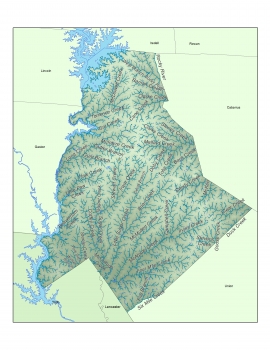
The creek heads through the industrial area at NoDa and between the former textile-mill neighborhoods of Belmont and Optimist Park. It enters uptown hidden by the looping lanes of a highway extravaganza, where the Brookshire Freeway meets Independence Boulevard.
The creek once marked the border between the African American neighborhoods of Cherry and its uptown rival, Brooklyn, leveled by 1960s urban “renewal” programs.
A newly visible section, once hidden under concrete, flanks a greenway along Kings Drive. The greenway sidles past Carolinas Medical Center, navigates Freedom Park and ends behind 1950s-vintage Park Road Shopping Center. A little beyond is the confluence with Briar Creek at Tyvola and Park roads. A few feet beyond sits the Sugar Creek Wastewater Treatment Plant, built in 1927 when the site was miles from town. 1
It flows through south Charlotte, Pineville and the President James K. Polk State Historic Site. Less than half a mile into South Carolina it meets Sugar Creek, which also carries to the Catawba River water from Charlotte’s Irwin and McAlpine creeks. It carries a visible plume of Charlotte-generated trash and pollution. Deeper in South Carolina, the Catawba becomes the Wateree and then the Santee. And at last, the creek born in a puddle behind a parking lot finds a grander home – the Atlantic Ocean.
HEADWATERS, HEZEKIAH AND SPRINGS
Inside a stone hut in east Charlotte, a man in Colonial-era knee-breeches dips a gourd into about 3 inches of water flowing across a dirt floor. He drinks.
The water is cool – always 54 degrees, says Tom Phlegar – and tastes as pure as Evian. It may not be the safest drink in town, but Phlegar has been swigging spring water at the Hezekiah Alexander House for 12 years and says he hasn’t gotten sick yet. (Experts caution not to drink from a spring unless it’s been tested for safety.)
Here, a few miles from the puddle off North Tryon is another of Little Sugar Creek’s birthplaces. It’s not ignored behind a car lot or littered with trash. This original springblock built by one of Charlotte’s earliest settlers, along with a rebuilt springhouse and the nearby rock house – Charlotte’s oldest surviving house – have historic significance and devoted caretakers.
In September 1766, Hezekiah Alexander bought 300 Mecklenburg County acres and settled “beside a tributary of Sugar Creek known as Alexander’s Mill Creek [today it’s called Briar Creek] … about two miles southeast of the Sugar Creek Presbyterian Church.” 2
Phlegar, who volunteers at the Charlotte Museum of History, tells visitors how the cool springwater kept foods from rapid spoiling in hot weather before refrigeration.
For water sources settlers probably preferred springs like these over creeks which, like rivers, can flood or carry contamination. Creeks go dry; springs offer cooler, safer, steadier water.
Most springs in Mecklenburg aren’t as carefully tended as this and, unless one is oozing water under your house, aren’t much noticed. But they play an essential, if quiet, role in the larger narrative of Mecklenburg’s 3,000 miles of creeks.
On average 40 to 50 percent of the water in small to medium-sized creeks comes from groundwater seeping in along the creek bed. 3
The water that burbles almost like a miracle into the Alexander springhouse is, in its modest way, the product of a dance between rain and rock. It fell as rain months or even years ago, soaked into the soil and then into a deeper substance, saprolite. Saprolite looks like rock but is soft enough to shovel. Some call it “dirt-rock” or “rotten granite.” It’s rock that has broken down over time; not soil, but not rock either. Like the bedrock below, saprolite has crevices where water seeps in and is stored.
There, warm summer rains and chilly winter rains mix. In Charlotte they average out to a constant 55 degrees or so. In some spots, especially hills or sloping creek banks, the saturated saprolite meets the surface, its stored water oozing out, as springwater into the creek.
Modern ruins of an old mill
Behind the Myers Park High School auto tech building, three crumbling rock walls hide in the undergrowth near Briar Creek. Littered with plastic bags and an empty whiskey bottle, these are the ruins of a now-vanished economic system and community center – a water-powered mill.

Here, in the 1850s, Isaac Newton Alexander built a two-story grain mill on Briar Creek. Its millpond covered part of what’s now the Myers Park Country Club golf course. The mill operated until the early 1890s, grinding flour and corn meal, and peanut and castor bean oil. It even produced the first cottonseed oil in Mecklenburg County. 4
Perched near creeks around the county, mills were civic, social and commercial centers for the era’s small farming communities. But 19th-century steam power and industrialization ended the era of creek-powered mills.
The sturdy rock foundations of I.N. Alexander’s mill are a designated landmark. The millstones sit near the front of the high school.
‘DEATH-DEALING NUISANCE’
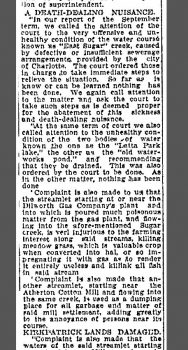
Founded as a crossroads hamlet in the 1760s, Charlotte grew. People and businesses took full advantage of nearby streams as places for dumping. Outhouses perched above the creeks. Industries spewed waste into the water. The city has no sewer service until 1876 and didn’t open its first sewage treatment operations until 1903. 5 Creeks in the city, especially Little Sugar and Irwin, grew nasty.
By 1907, a Charlotte Daily News article described a local grand jury calling “east Sugar Creek” a “death-dealing nuisance,” noting that a streamlet near Dilworth Gas Works “into which is poured much poisonous matter from the gas plant, and flowing into the afore-mentioned Sugar Creek, is very injurious to the farming interest along said streams, killing meadow grass … and killing all fish in said stream.”
The article describes how “Another streamlet, starting near the Atherton Cotton Mill and flowing into the same creek, is used as a dumping place for all garbage and matter of said mill settlement.” 6
The next half-century brought repeated efforts to stop flooding, filth and stench. Meanwhile, development put roofs and asphalt on land where rain once soaked into soil and put buildings into the space alongside creeks where floodwaters once spread out – floodplains. Not surprisingly, flooding worsened.
The city tried putting chlorine and other chemicals into the water to help treat the raw sewage. It fogged the creek regularly with DDT. 7
By the late 1940s a proposed city ordinance required industrial wastes to be treated “to render them odorless and harmless” and put into city sewers. But business protests stalled adoption, and once adopted, the city stalled enforcement. In 1956, the year the ordinance was finally enforced, Observer reporter Larry Jinks wrote, “Sugaw Creek—once the smelly scourge of Charlotte – has reformed.” 8
He spoke too soon.
‘IT WAS ALWAYS CLOUDY, MILKY’
Summer 1969. Ted Kennedy has driven off a bridge on Chappaquiddick Island, and a rock festival takes place in Woodstock, N.Y. In Charlotte, a crew-cut man carrying a notebook wades down Little Sugar Creek. He’s looking for suspicious pipes. Pat Stith, 27, Charlotte News reporter, is investigating illegal pollution in the creek.
He finds plenty to write about.
“You never saw any clean sparkly water. I can tell you that,” he recalls 45 years later, after a Pulitzer-winning career at the News & Observer of Raleigh. “It was always cloudy, milky. There was nothing about that creek that looked inviting.” 9
He waded 19 miles from Hidden Valley to south of Pineville. He arranged for Ed Menhinick, a UNC Charlotte biologist, to examine the creek for aquatic life. In “Catch Any Fish In Sugar? You Can Forget About It,” he reported that after using nets at three spots they found “one dead frog, one live earthworm, two beer cans and several hundred cigarette butts. They did not find any fish.” 10
Another headline read: “The Creek Is Simply A Sewer.”
DOWNLOAD THE FULL 1969 SERIES HERE
“It smelled of sewage, and it was obviously discolored, and there was trash up and down the creek,” Stith recalls. Other than one snake, he says, “You didn’t see any kind of wildlife, except rats.”
Stith found more than two dozen businesses apparently piping waste into the creek. “Some of these people owned up to it,” he says, “some of them said, ‘Well it’s possible.’ And some of them said, ‘I didn’t do it,’ despite what I thought in a couple of cases was overwhelming evidence that they did.”
He published his evidence, including chemical analyses of what was trickling from pipes, and a list of apparent scofflaws. One polluter was the City of Charlotte. Because apartment development had strained sewer capacity, the city put in a sewer line overflow pipe to dump untreated sewage into Briar Creek just below Eastway Drive.
“This sewage would run straight into the creek,” Stith says. “I mean, I just had never seen anything like that before or since. Right downstream from that, there’s residential neighborhoods. So these kids, if they went out and played in the creek, they really were essentially playing in sewage. They [the city] didn’t tell anybody anything.”
Laws, ordinances get tougher
Stith’s 1969 investigation got results. The then-chair of the county commissioners was a Davidson College chemistry professor, Jim Martin, a Republican who’d later serve in Congress and as N.C. governor from 1985 to 1993. After Stith’s articles, Martin said county commissioners should take the initiative to clean up Mecklenburg’s creeks. 11
In 1970, Mecklenburg County created a Department of Environmental Protection. “The first thing they did,” recounts Rusty Rozzelle, “was to try to find out where all this raw sewage was coming from. And in order to do that, they started walking creeks.” *
That, says Rozzelle – a longtime county environmental employee who’s now water quality program manager for Charlotte-Mecklenburg Storm Water Services – led to adoption of a new ordinance. “They found out people weren’t going to voluntarily spend a bunch of money to get the sewage out of the creeks.”
An even larger change came in 1972 with the Clean Water Act. Its early incarnation targeted chemicals and sewage being piped into the nation’s rivers, lakes and streams. Over time, the worst of the chemical and sewage pollution in Little Sugar and other Charlotte creeks began to ease.
Yet still, the creeks were troubled. Stormwater runoff from ever-expanding pavement and rooftops brings many of today’s pollutants.
A MAGNET FOR KIDS
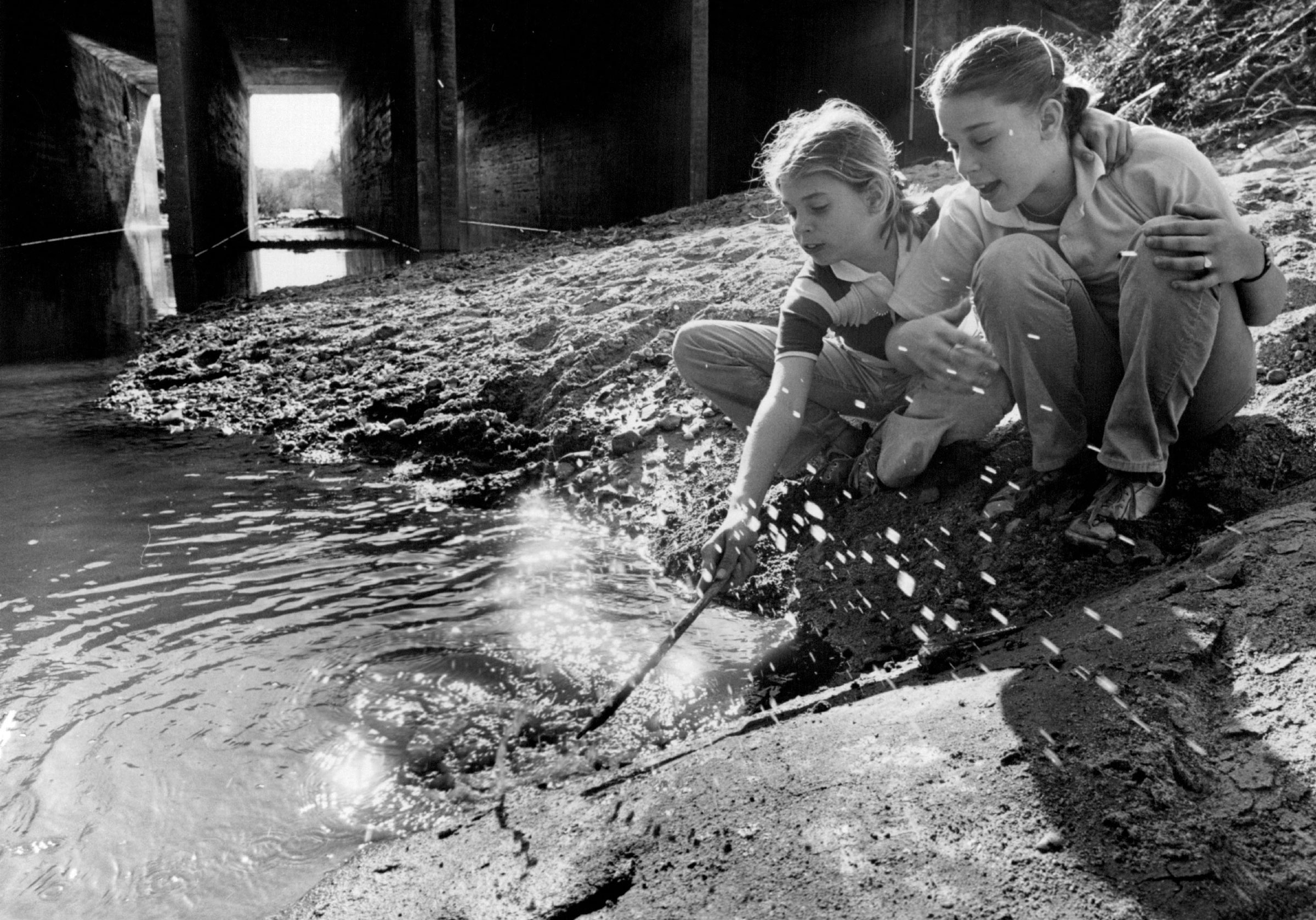
Even so, talk with Charlotteans over a certain age and you’ll hear tales of playing in creeks – even foul Little Sugar – often followed with a chuckle and a mention that the water was probably polluted.
Richard Perry, 80, remembers a swinging bridge across Little Sugar Creek, linking Cherry and Brooklyn. Kids would bounce on it, he remembers, and when the creek was high after a rain, they’d make the bridge slap the water. That led to a tragedy, he remembers. Along about 1939, he says, the bridge broke as kids played on it. As he and other residents recall the incident, nine to 12 children drowned.
Some avoided Little Sugar Creek’s waters. Charles Patton, 78, who grew up in Cherry, remembers cow droppings from the dairy farm at nearby Thompson Orphanage and chemicals from a nearby dry cleaner.
The era’s racial segregation barred black citizens from city swimming pools. So kids swam in the creeks. Cherry kids knew the best swimming hole around was a mile and a half away in Briar Creek behind the Mint Museum. “We would walk from Cherry all the way to Griertown to swim,” Perry recalls. “That was the deepest water around. We called that the Big Boy Hole.” 12
Mention the Big Boy Hole – and yes, there was a Little Boy Hole, where smaller kids learned to swim – to people who grew up in Grier Heights, and the memories bring laughter. Women say they never swam there, just peeped at the boys, who typically swam naked. And it wasn’t just the Grier Heights kids.
“The Big Boy Hole is where a lot of the more prominent families’ children – mainly the Belks and others – where their kids swam, behind the Mint Museum,” recalls George “Porgie” Wallace, 72.
“Sugar Creek looked dirty,” says Willie Davis, 86, now of Washington. “The Little Boy Hole and the Big Boy Hole looked clear. We didn’t realize they were probably just as dirty.”
Decades later, across town, white kids were playing in the creek, too. Today Douglas Rader has a Ph.D. in biology and is chief oceans scientist for the national Environmental Defense Fund. But for him and his boyhood “snake-catching buddy,” he recalls, “Little Sugar Creek was our natural habitat. I think we walked and hunted the whole reach from Freedom Park all the way down to the Tyvola Road sewer plant numerous times.”
He assumes, now, that he was wading in polluted water.
Similarly, Les Todd, 62, grew up near Freedom Park with Little Sugar behind his house. “You know boys,” he says. “We could have fun and go down to the park and the next thing you know we’re down playing in the creek.” Did he ever think about pollution? “Never crossed my mind,” Todd says.
A CONCRETE CAP GOES ON, COMES OFF
By 1959, American suburbia was booming. In Charlotte, 50,000 people came to the Oct. 28 grand opening for Charlottetown Mall, the Southeast’s first enclosed shopping mall, built by Jim Rouse, one of the country’s most influential developers. 13
Its concrete parking lot was atop Little Sugar Creek.
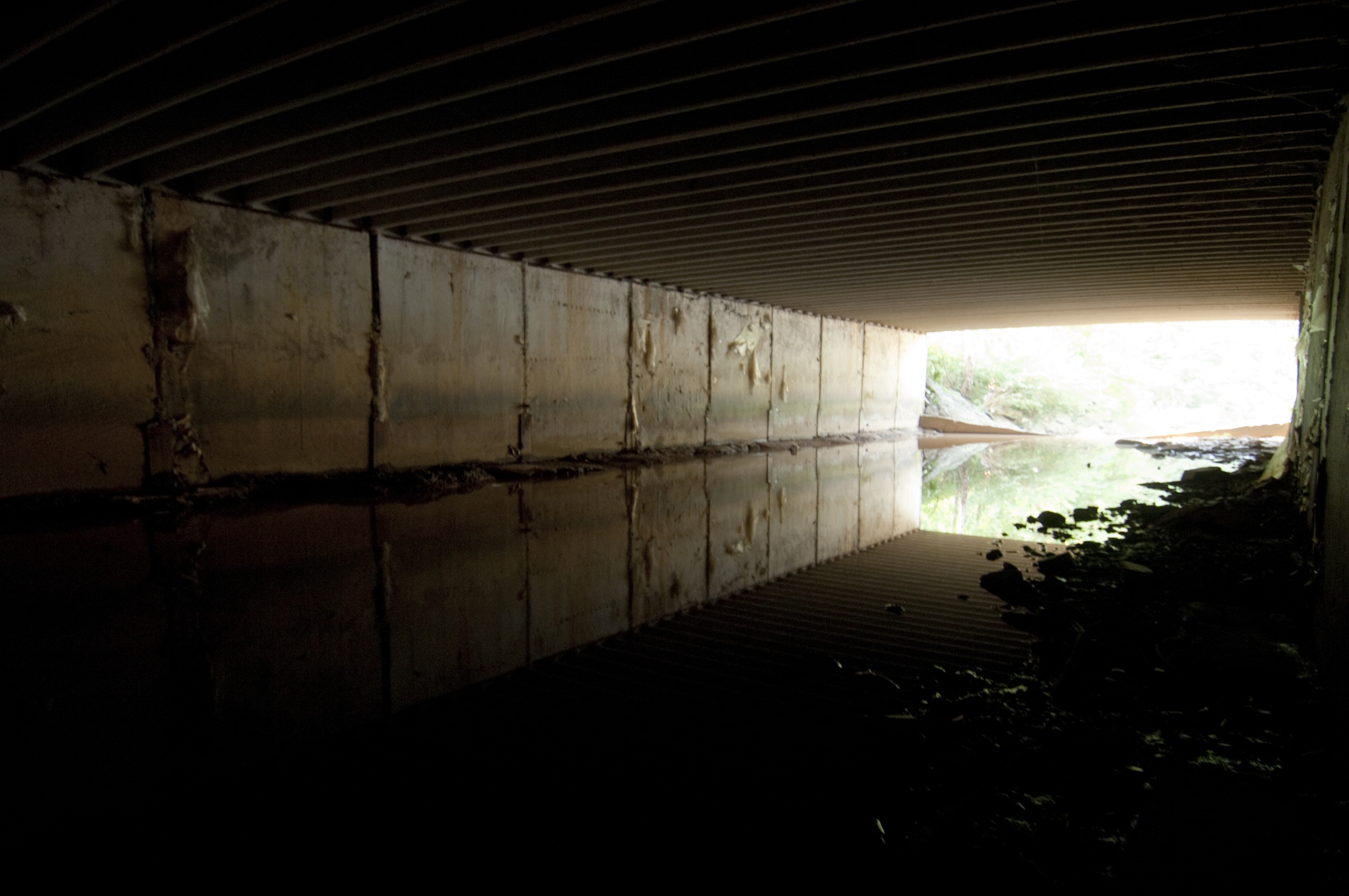
In a 2005 interview, long-time Charlotte engineer Pete Verna remembered his work for Rouse, who had decided in September, two months before the opening, more parking was needed. Verna complied. “I covered all that,” Verna said. “I covered the creeks.”
Nearby businesses wanting parking space did the same, putting Little Sugar in the dark for more than 40 years.
By that 2005 interview with Verna, plans were in place to demolish the concrete caps. The mall came down in late 2005, replaced by the Metropolitan development and a prominent segment of the Little Sugar Creek greenway, which opened in 2010. That $42 million state-local-private project added not only the greenway path but water-quality improvements such as meanders, riffles, rain gardens and natural plantings. What was once the most polluted waterway in North Carolina had become an amenity.

Over 40 years, new measures such as ordinances requiring up to 100-foot creek buffers, flood-prone property buyouts, and stream restoration projects have aimed to improve Mecklenburg’s creeks. Along Little Sugar, the stench and visible pollution are mostly gone. Fish returned. You’ll spot great blue herons, mallards and Canada geese.
On a July day, 45 years after wading a filthy Little Sugar Creek, Pat Stith took another look, visiting the new greenway near uptown for the first time.
He pointed to some Canada geese. “I don’t remember seeing any birds in the creek, ever.” He saw minnows darting. “Look at those fish. That’s something you didn’t see.”
He spotted only one piece of trash. His verdict: “The creek, it’s a different animal altogether.”
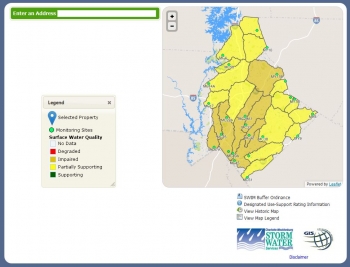
But, Stith pointed out, water quality tests would tell the full story. And the story they tell is that, like all Mecklenburg’s creeks, Little Sugar remains polluted.
Its upper and lower sections are rated “impaired.”
The county lists today’s problems: turbidity (muddy water), copper, lack of diversity of aquatic insects, lack of fish-species diversity, fecal coliform (a bacteria found in feces), as well as, in the upper section, mercury. 14 15
If the factory pipes are gone, where is the pollution from? Today’s polluters are diffuse, hard to pinpoint at one place. Rain pouring off construction sites, lawns and pavement brings mud and sediment, lawn chemicals, brake fluid and heavy metals. Sewer line overflows spewed bacteria. Sewage treatment plants contributed phosphorus and nitrogen. Speeding floodwaters scraped away the habitat for aquatic life. As bad as the pollutants are, just as bad are the speed and volume of the runoff, which scrapes away habitat.
WHAT FUTURE AWAITS?
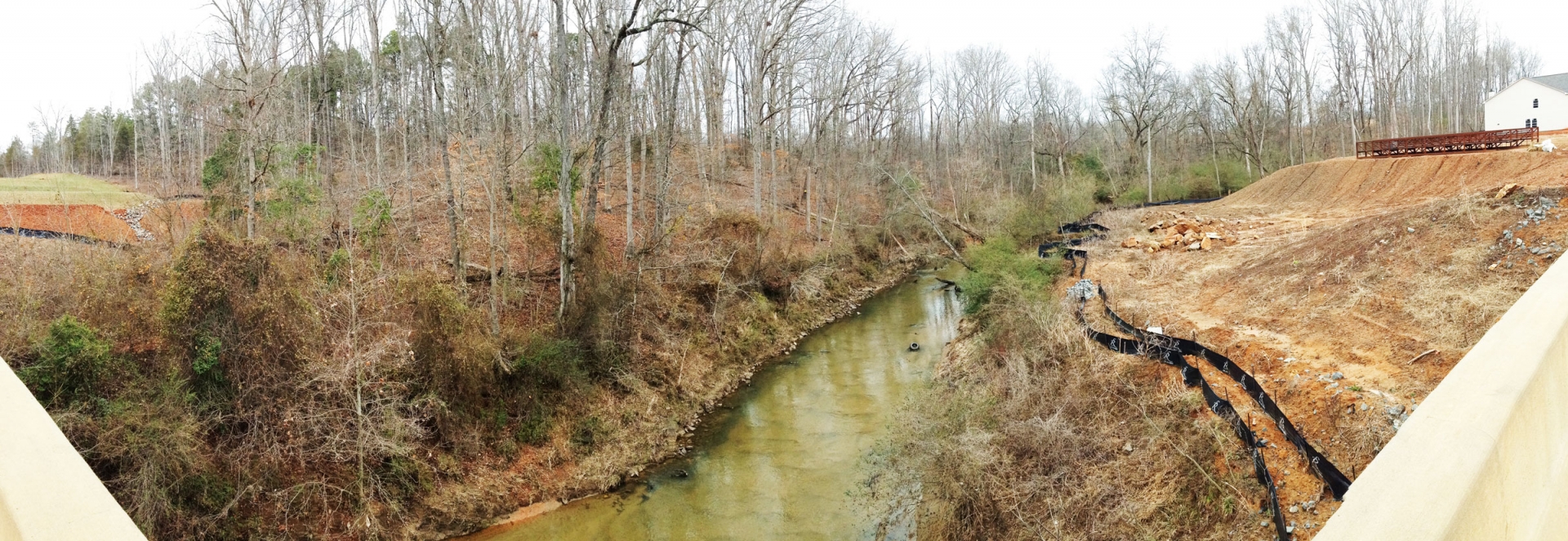
As Little Sugar Creek continues through a series of south Charlotte subdivisions, it resembles a shallow river. Residents over the years have reported seeing otters and landing bass and even a 10-pound catfish.
It meanders behind Pineville’s shopping centers and parking lots, twists past President James K. Polk’s birthplace. Then it winds into Lancaster County, S.C., on its way to the sea.
One February morning, five old tires poked through sediment in the creek below a new concrete bridge on Gilroy Road just south of the S.C. line, about a half mile upstream from Little Sugar’s confluence with “Big” Sugar Creek. Plastic silt fences lined the east bank, where a sign announced a new subdivision swimming pool. A flock of cedar waxwings skittered into a bare tree.
Cement trucks and half-built houses lined Gilroy Road – just one scene in the century-long drama of growth at the city’s edge. More rooftops, more sewer lines, more pavement, more runoff into the creek already carrying Charlotte’s treated wastewater, stormwater, old tires and countless plastic bags and bottles.
Bill Stokes lives in Lancaster and kayaks the Catawba River. He has been fishing city garbage out of the river several decades ago. Paddling the river, he says, it’s fairly clean north of Sugar Creek. “Once you get to Sugar Creek, though, it’s like someone opened the garbage floodgates.”
*A note of disclosure: The Charlotte storm water education office of Charlotte-Mecklenburg Storm Water Services donated funds to assist with artist Stacy Levy’s educational project in Revolution Park, Passage of Rain, a part of the overall KEEPING WATCH on WATER: City of Creeks project.
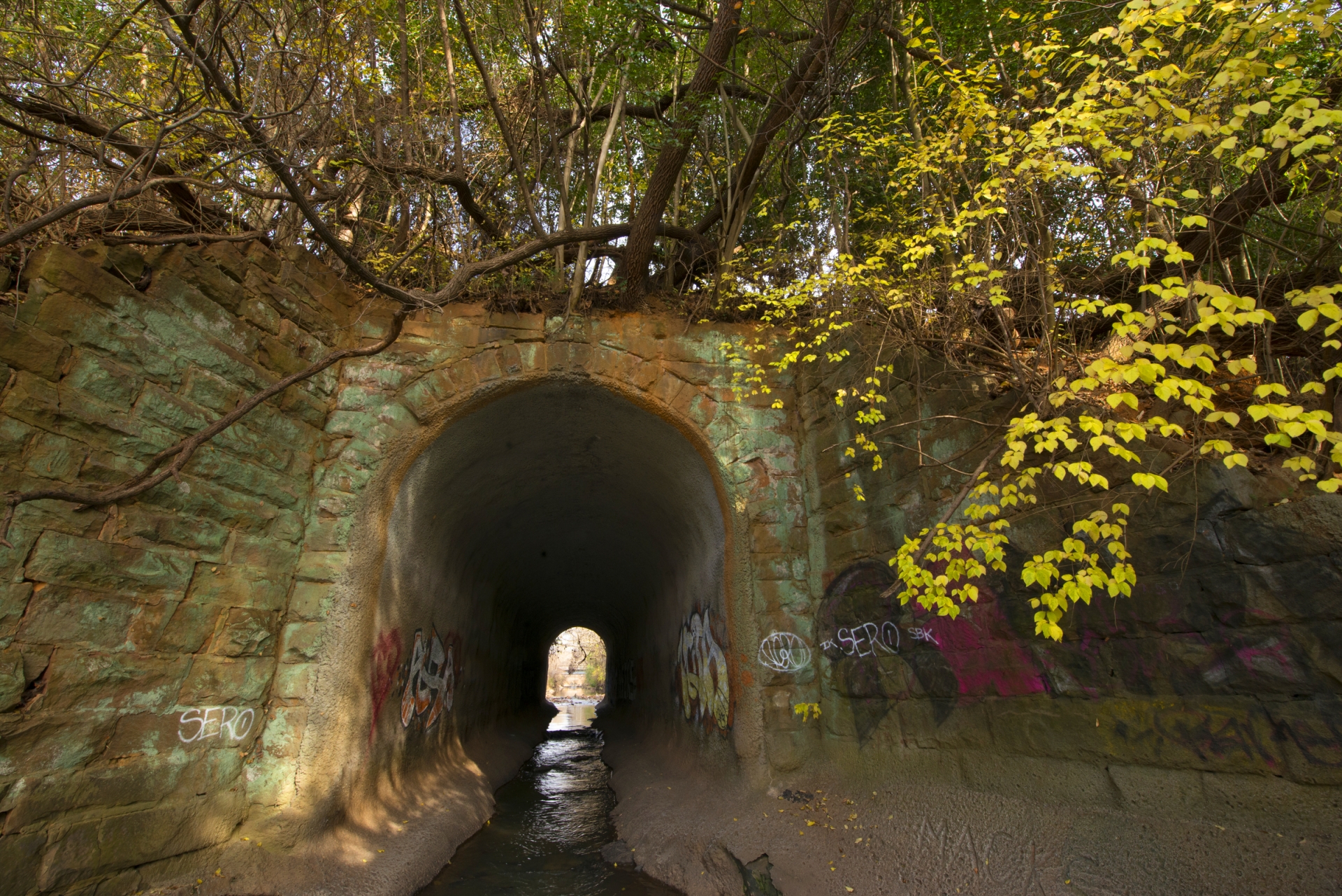
- Charlotte Water, http://charmeck.org/city/charlotte/Utilities/AboutUs/Pages/History.aspx
- Hezekiah Alexander and the Revolution in the Backcountry, by Norris W. Preyer, p. 43.
- Sustainability of Ground-Water Resources, by William M. Alley, Thomas E. Reilly and O. Lehn Franke, U.S. Geological Survey, http://pubs.usgs.gov/circ/circ1186/html/gen_facts.html
- http://www.cmhpf.org/S&Rs%20Alphabetical%20Order/surveys&ralexandermill.htm
- http://charmeck.org/city/charlotte/Utilities/AboutUs/Pages/History.aspx
- “The Grand Jury Reports,” Charlotte Daily News, Dec. 7, 1907.
- “Will Lessen Sugaw Creek’s Filth, Stench,” by Hal Tribble, July 9, 1949, Charlotte Observer.
- “Sweetness Comes To Sugaw Creek,” by Larry Jinks, Aug. 19, 1956, Charlotte Observer.
- Interview, July 28, 2014.
- “A Sewer Named Sugar,” by Pat Stith, multiple articles, Sept. 15-18, 1969, Charlotte News.
- “ ‘Unhealthy Conditions’ Emphasized,” by Pat Stith, Sept. 19. 1969, Charlotte News.
- Recollections of life in Cherry from interviews Aug. 16, 2014.
- http://clclt.com/theclog/archives/2013/04/26/question-the-queen-city-charlottetown-mall-and-its-nearly-forgotten-time-capsule
- http://charmeck.org/stormwater/whatsmywatershed/Pages/UpperLittleSugarCreek.aspx
- http://charmeck.org/stormwater/whatsmywatershed/Pages/LowerLittleSugarCreek.aspx




